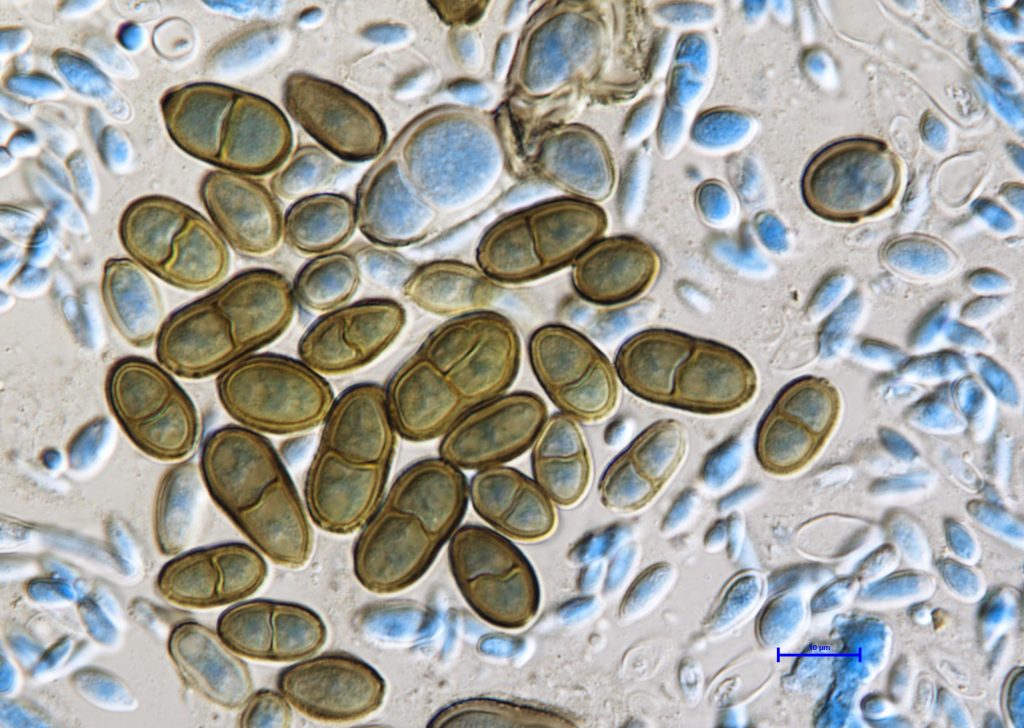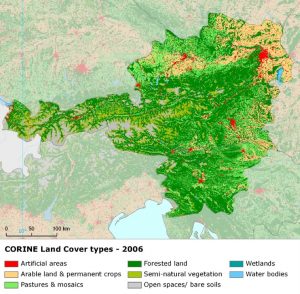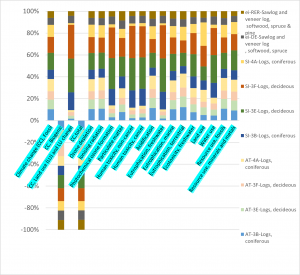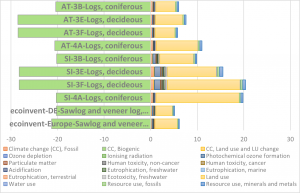
July 26, 2024


Science is virtually sure that human beings contribute to climate change and that this needs to stop immediately to reduce dangerous climate change. Therefore, more than one-hundred-ninety nations, including the European Union, have signed the Paris Agreement (United Nations, 2021) to strengthen the global response to the threat of climate change by limiting the global temperature increase to 2 °C (and pursuing efforts for 1.5 °C ) above pre-industrial levels (United Nations, 2015). To meet these conditions requires a steep decline in greenhouse gas (GHG) emissions by the year 2030 and zero emissions by 2050 (IPPC, 2018). One option, in addition, to stop burning fossil fuels are nature-based solutions like using the forest as raw materials instead of fossil and mineral-based.
Slovenia has a forest coverage of 58 % while almost half of Austria is covered by forest (48 %). In these countries, thus the forest-based sector has an important role. However, the environmental impact of logs in these countries are not well described. For example, in the ecoinvent database, which is one of the most well-known databases for LCA, European forestry products are based on data from Sweden, Germany and Switzerland only.

Figure 1: Austria and Slovenia and CORINE Land Cover types [illustration from Schau et al, (2021) based on EEA (2011)]
Therefore, researchers from InnoRenew CoE (Slovenia), UniGraz (Austria) and VITO (Belgium), presented a poster (Schau et al. 2021) at the 10th International Life Cycle Management Conference 2021, which explored and compared some forest management systems in Austria and Slovenia with the aim to 1) describe the environmental impact of Slovenian and Austrian forestry and forest products with a focus on sawlogs, and 2) provide life cycle inventory data for Slovenian and Austrian forestry and importing countries for other footprinting needs, for example, life cycle assessment or carbon footprinting in the construction and biorefinery sectors and for benchmarking purposes. The poster has subsequently been expanded to an open access journal paper submitted to E3S Web of Conferences – LCM 2021 – Building a Sustainable Future Based on Innovation and Digitalization – Findings From the 10th International Conference On Life Cycle Management, currently under review.
To achieve those goals, the researchers explore the use of the European Life Cycle Inventory of Forestry Operations (EFO-LCI) database (Cardellini et al. 2018). This database classified European forests based on the adopted silvicultural systems and species composition. Data from EFO-LCI has been extracted and calculated to fit the ecoinvent dataset input and output (see Figure 2). Additional data on fencing has been gathered from a scientific paper by Cambria and Pierangeli (2012).

Figure 2. Simplified illustration of the cradle-to-gate system boundary with input and output, based on the ecoinvent database v 3.6 (Wernet et al, 2016).
The EFI-database supplemented with the ecoinvent method and data from scientific literature on fencing made it possible to describe the environmental footprint of logs from some specific Austrian and Slovenian forest management practices. The life cycle impact assessment method applied was 16 impact categories as recommended by the European Commissions for LCA/Environmental Footprint in Europe (EC, 2013) and provides additional indicators for the climate footprint, important for biobased materials. Figure 3 shows the characterised results from the life cycle assessment. The results show that there are large differences between the environmental impact of different forest practices, but also between countries. For example, in the Eutrophication, freshwater indicator, this range from 1.4 kg phosphor equivalent (for the Slovenian light-demanding coniferous with uniform clear cut even-aged management 4A) to 25.2 kg phosphor equivalent (for the Slovenian slow-growing light-demanding non-coniferous with shelterwood even-aged management 3E) (all per m3 of wood logs at forest roads). This is almost a factor of 18 between the minimum and maximum. Another example is climate change, fossil, where the impact ranges from 11 kg CO2e for the European ecoinvent dataset on spruce and pine, 13.8 kg CO2e for the Austrian 3F forest unit to a maximum of 27.9 kg CO2e for the Slovenian 3E forest unit. This is a factor of 2.5 between the minimum and maximum. Therefore, it is recommended for buyers of wood logs to get more exact life cycle environmental data on the forest products they buy. Data collection in forestry could start with the environmental data as indicated in Figure 2.

Figure 3. Characterised results, showing the percentual contribution of 1 m3 of wood logs at forest road for different forest management systems for different environmental impact indicators (x-axis).
Normalised and weighted Environmental Footprint 3.0 indicators (Figure 4) show that the selected datasets for Austria and Slovenia have in sum a higher environmental impact than the reference datasets from ecoinvent. Land use is a hot spot, however, for all investigated forestry datasets, the weighted impact is negative, due to the amount of carbon stored in the wood. This assumes sustainable forest management, where cut trees are replaced by new seedlings (naturally or planted).

Figure 4: Normalised and weighted results. Unit is mpt (Figure from Schau et al, 2021).
According to this analysis, the occupation of land is the most important environmental impact of Slovenian and Austrian forestry. The harvesting (sawing) of the trees is a main contributor to emission to air. However, this is offset by the ability of trees to store carbon from CO2 in the atmosphere. Increased demand for forest products could lead to more intensive production, with more output per area used, which could result in lower environmental impact per m3 of wood harvested. The investigated database (EFO-LCI) could provide life cycle inventory data for Slovenian and Austrian forestry for other LCA needs, for example, LCAs in the construction or biorefinery sectors and for benchmarking purposes. However, as the variation in the results is large, specific environmental data on actual wood logs are important for more accurate results.
Erwin M. Schau
InnoRenew CoE, Livade 6, SI-6310 Isola-Izola, Slovenia
European Commission (EC) (2013) Commission recommendation of 9 April 2013 on the use of common methods to measure and communicate the life cycle environmental performance of products and organisations. 2013/179/EU. Brussels
European Environment Agency (EEA) (2011), CORINE Land Cover Type (Austria and Slovenia) Last visited 14 Sept 2021: https://www.eea.europa.eu/data-and-maps/figures/land-cover-2006-and-changes/
Eurostat (2018) Land use overview by NUTS 2 regions (LAN_USE_OVW)
Cardellini G, Valada T, Cornillier C, et al (2018). EFO-LCI: A New Life Cycle Inventory Database of Forestry Operations in Europe. Environ Manage;61(6):1031-1047. doi:10.1007/s00267-018-1024-7
Wernet G, Bauer C, Steubing B, Reinhard J, Moreno-Ruiz E, Weidema B. (2016). The ecoinvent database version 3 (part I): overview and methodology. Int J Life Cycle Assess. 2016;21(9):1218-1230. doi:10.1007/s11367-016-1087-8
IPCC (2018) Global Warming of 1.5°C. An IPCC Special Report on the impacts of global warming of 1.5°C above pre-industrial levels and related global greenhouse gas emission pathways, in the context of strengthening the global response to the threat of climate change, sustainable development, and efforts to eradicate poverty [Masson-Delmotte, V., P. Zhai, H.-O. Pörtner, D. Roberts, J. Skea, P.R. Shukla, A. Pirani, W. Moufouma-Okia, C. Péan, R. Pidcock, S. Connors, J.B.R. Matthews, Y. Chen, X. Zhou, M.I. Gomis, E. Lonnoy, T. Maycock, M. Tignor, and T. Waterfield (eds.)]
Schau, EM, Asada, R, Slavec, A and Cardellini, G (2021) Life cycle assessment of Austrian and Slovenian raw wood production, The 10th international conference on life cycle management, Stuttgart/Online: 1-8 September 2021
United Nations, Chapter XXVII – Environment – 7.d; Paris Agreement 2015. United Nations Treaty Collect. Secretary-General, United Nations (2021): https://treaties.un.org/pages/ViewDetails.aspx?src=TREATY&mtdsg_no=XXVII-7-d&chapter=27